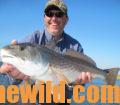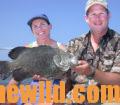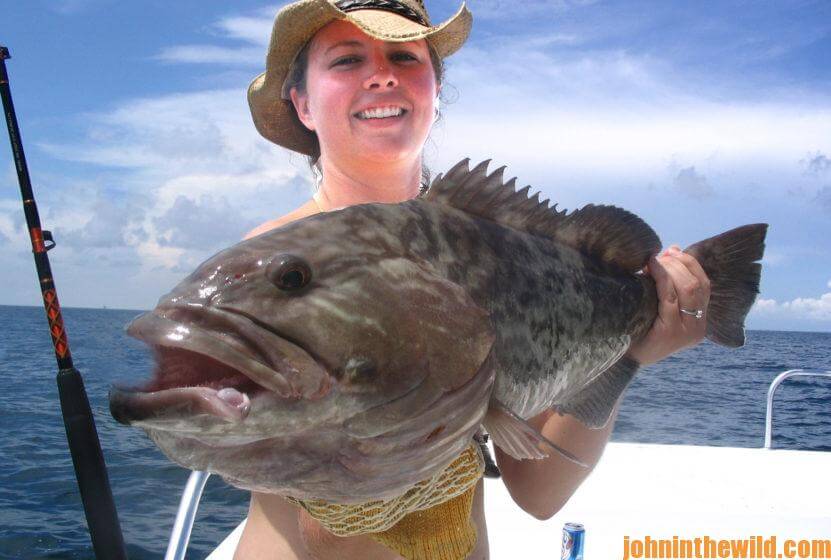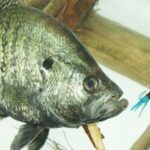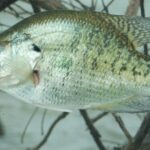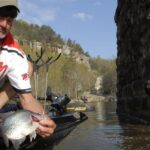Editor’s Note: With many school systems pushing back the start of school in 2020, and with many schools holding virtual classrooms, families are headed to the Gulf of Mexico to enjoy the sand, the water and the fishing. Here are some ideas for productive inshore and offshore fishing.
You can catch grouper in the Gulf of Mexico, but be sure to check the regulations about fishing for grouper before you try these tactics. Plenty of hard-fighting, delicious-eating, photo-taking grouper are available to be caught offshore of the Gulf Coast. Captain Don McPherson of the “Last Hook,” docked at Zeke’s Marina talks about his longer trips of 10 and 12 hours, where his anglers will catch nice gag grouper and some even weighing about 30 pounds. “We catch quite a few that weigh 12 to 15 pounds and nice-sized scamp grouper on the longer trips,” McPherson explains.  “Another option that we have on the 12-hour trip is deep-drop fishing. We had a trip in mid-July one year with only two people on board and caught 6 nice snowy grouper, with the largest weighing about 30 pounds. We also took some really-nice tilefish and longtail sea bass. These deep-water fish that live down in the very-cold 500- to 1,000-foot deep water are delicious to eat. To catch these fish, we use power-assisted reels produced by Daiwa
“Another option that we have on the 12-hour trip is deep-drop fishing. We had a trip in mid-July one year with only two people on board and caught 6 nice snowy grouper, with the largest weighing about 30 pounds. We also took some really-nice tilefish and longtail sea bass. These deep-water fish that live down in the very-cold 500- to 1,000-foot deep water are delicious to eat. To catch these fish, we use power-assisted reels produced by Daiwa
(https://www.daiwa.com/us/products/reel/power_assist/index.html) that allow you to either wind the fish up or the reel to wind them up for you. These new, lighter reels are much quieter than the old reels we once used. Deep-water grouper fishing has been really, really good. I know getting out to these places to fish is a long way to go and requires a long time to get there, but the payoff will be worth the trip. Not only do we catch gag grouper, scamp grouper and red grouper on the way out to where we deep-drop, we can catch the snowy grouper, tilefish and longtail sea bass once there, as well as a good variety of other fish. Sometimes we have to use our fish-identification book to identify some of the other fish we’re catching.
“When we’re deep-dropping, we use whole squid, cut bait and whole cigar minnows. We’ve also found that slabs of bonito are productive baits for these deep-water grouper, since they seem to prefer bait with a strong scent to it. Another advantage of the 12-hour-fishing trip is on the way out and on the way back, we troll through some great waters for catching wahoos and big king mackerel. Both these fish will eat high-speed trolling baits that we put out behind the boat while we’re making one of those long runs. We can take up to 6 people on our boats a 12-hour trip. We usually leave about 6:00 am and return by 6:00 pm. We are starting to slowly see more people opt for the longer trips, especially, if they’re coming down to catch fish for their freezers. We started fishing for the deep-water grouper about 4-years ago and have seen the demand for this trip steadily increasing. We’re still running quite a few 4-hour trolling trips and are seeing 5-hour trips starting to grow in popularity where you can troll for Spanish and king mackerel, an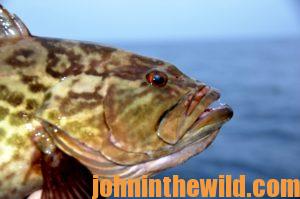 d catch and release a few red snapper. But, to catch fish to take home, most people are choosing the 8, 10 and/or 12 hour trips.”
d catch and release a few red snapper. But, to catch fish to take home, most people are choosing the 8, 10 and/or 12 hour trips.”
Contact Don McPherson at 251-981-8047, email [email protected], or go to his website at https://getawaygulffishing.com/getaway-charters-team/ to learn more.
Use the Correct Line:
When I watched a wiry deckhand who probably weighed about 125 pounds whip a 42-pound grouper in less than 15 minutes, I decided to study his technique. The speed at which you hook and move the grouper out of its hole or off the bottom directly relates to the chances you’ll have for landing the grouper. Anglers hook most grouper in deep water. When you fish in deep water with monofilament line, the line usually bows because monofilament tends to float and stretch. For these two reasons, you can’t deliver the force to the point of the hook that you need to as soon as you feel the grouper take the bait. If you fish with monofilament line, you have to reel first. Then when you feel the pressure of the fish, you must set the hook. The delay from the time you feel the bite until you actually set the hook on the grouper can make the difference between winning or losing the battle with the fish. For this reason, I fish with the new braided, super-strong, small-diameter lines. Because of their small diameters, these lines have much-less bow in them than monofilament does. Their super strength means you can transfer more power to the hook more quickly with these new braided lines than you can with monofilament.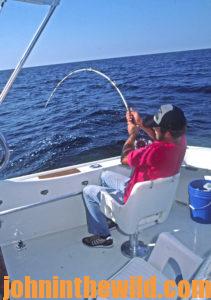
Get a Grouper to Bite:
The grouper acts as the garbage man of the ocean’s bottom, eating almost any bait you send to the bottom at any time. However, even the garbage man has preferences. Grouper like to hit either a large bait like a big pinfish or a small beeliner snapper. Many times the grouper will want a dead bait, because the grouper doesn’t want to expend much energy catching and eating its food. A large variety of dead baits will work, but for some reason, two particular dead baits draw the most attention from grouper – butterflied bait and a squid pie. Any fish that swims can work as a butterflied bait, but grouper like beeliners or northern mackerel the best. To butterfly a bait, fillet the bait on both sides, starting at the tail. When the blade of the knife reaches the head of the fish, don’t cut off the fillet. Turn the bait over, and fillet the other side of the bait. Then remove the backbone from the middle of the two fillets. You then have two fillets on either side of the head with no backbone in the middle. Hook this bait through both lips, bringing the point of the hook out of the lips of the bait.
For the squid pie, force a whole cigar minnow as far as you can into the center of a large squid so that the squid appears to have swallowed the entire cigar minnow. Put the point of the hook through the squid and through both eyes of the cigar minnow.
These baits:
* present big baits for the grouper to eat,
* stay on hooks better than other baits and
* provide enough meat so that if the grouper doesn’t eat all the bait the first time it hits it. Therefore, some of the bait will remain for the fish to bite. By fishing with this type of bait, you double your chances of catching the grouper.
Even if you have a bait that a grouper should eat, and you fish with the kind of line that should enable you to get a quick hook set and pull the grouper away from the structure quickly, you still may not land the grouper. The way you fight the fish will determine your success. I’ve fished on boats before where we’ve had 20 to 30 grouper bites in a day and only have landed one or two fish. The angler’s reaction when he feels the bite often results in that poor strike-to-capture ratio.
Fight a Grouper:
You win or lose the battle with a grouper during the first 6 feet of the fight. As soon as you feel the bite and set the hook, you have less than 15 seconds to pull that grouper out of its hole, turn its head up and start reeling it up to the surface of the water. If you lose that battle in the first 5 or 10 seconds, the grouper will get back in the hole and break your line. But, even slow, weak anglers can cheat and get that grouper out of the hole quickly. Here’s how. If you have an experienced captain on the boat, as soon as the fish 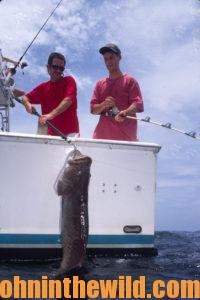 takes the bait and you set the hook, the captain immediately should throttle forward to increase the speed to help you set the hook and pull the fish out of the hole and away from the structure. This tactic provides the quickest and most- efficient way to make sure you catch the fish without breaking your line. But the battle doesn’t end once you get the grouper away from the structure. Tighten your drag as much as possible when you strike the fish and pull it out of the hole. Deliver all the power you can to the point of the hook on the initial strike while you retrieve those first 10 to 15 yards of line. But once you get the grouper 10-15-feet off the bottom, loosen the drag to let the drag system fight the fish.”
takes the bait and you set the hook, the captain immediately should throttle forward to increase the speed to help you set the hook and pull the fish out of the hole and away from the structure. This tactic provides the quickest and most- efficient way to make sure you catch the fish without breaking your line. But the battle doesn’t end once you get the grouper away from the structure. Tighten your drag as much as possible when you strike the fish and pull it out of the hole. Deliver all the power you can to the point of the hook on the initial strike while you retrieve those first 10 to 15 yards of line. But once you get the grouper 10-15-feet off the bottom, loosen the drag to let the drag system fight the fish.”
After loosening the drag, pump the rod and wind the reel while keeping steady pressure on the grouper. You never want to play tug-of-war with a grouper by simply keeping the rod bent and trying to pull the fish up to the surface. Constantly pull against the fish, take up line, pull against the fish, and take up more line. Even if you only retrieve 6 inches of line at a time, you’re still gaining line. And, when the fish makes a run, stop reeling, and just hold on to the rod. But the instant the fish stops, pump, and wind. Many grouper anglers make the mistake of spending too-much time pulling against the rod and not enough time winding-in line. Regardless of how hard the grouper fights, any time you can lift the rod tip and gain an inch or two of line, you can win.
Once you get the fish away from the bottom, then your angling skills really come into play. You need to know when to pump and wind and when to let the fish pull off drag. When the fish pulls off drag, I don’t reel. If the fish doesn’t pull-off drag, I pump and wind. Even if the rod pulls off drag when I pump, I still fight for every inch of line I can get until I move the grouper well away from the structure. As with most saltwater fish, when you battle a grouper, you have to fight for line. If the fish takes in line, it wins. If you take in line, you win. To land a grouper, you need to know when to allow the fish to take line and when to fight to get back line.
Don’t Lose a Grouper:
If you have succeeded in hooking a grouper, pulling it away from the structure, fighting it in mid-water and getting it to the surface, you still haven’t put a grouper on the deck. Many grouper get lost when their heads hit the surface of the water. From the time you set the hook on the fish and start reeling, you’ll increase the size of the hole the hook has made inside the fish’s mouth. The longer you fight the fish, the bigger the hole becomes. The hook has a small barb. The barb keeps the hook 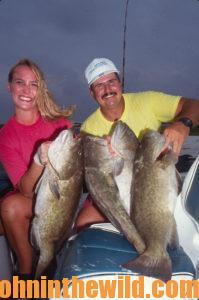 from backing out of the hole in the fish’s mouth once the hook gets set. However, if you wear a big hole inside the fish’s mouth, when the hook starts to fall back, the barb won’t catch meat. Then the hook simply will fall-out of the fish’s mouth. As long as you keep tension on the line, the hook usually will stay well-planted in the grouper’s mouth. The hook puts the least amount of pressure on the grouper when the fish’s head breaks the surface of the water. If a grouper throws its head from side to side once it comes above the surface, it not only makes the hole where the hook has entered the grouper’s mouth bigger, but the hook will likely fall out of the fish’s mouth.
from backing out of the hole in the fish’s mouth once the hook gets set. However, if you wear a big hole inside the fish’s mouth, when the hook starts to fall back, the barb won’t catch meat. Then the hook simply will fall-out of the fish’s mouth. As long as you keep tension on the line, the hook usually will stay well-planted in the grouper’s mouth. The hook puts the least amount of pressure on the grouper when the fish’s head breaks the surface of the water. If a grouper throws its head from side to side once it comes above the surface, it not only makes the hole where the hook has entered the grouper’s mouth bigger, but the hook will likely fall out of the fish’s mouth.
Unless you fish in a slick-and-calm Gulf of Mexico, you’ll have some wave action that causes the boat to rock back and forth. Therefore, when the grouper’s head comes out of the water, and the boat rocks up, you’ll pull against the fish. But when the boat rocks down, and the lead on your line pulls the line down, the hook can come out of the grouper’s mouth. For this reason, keeping the fish’s head under that water and having a fast first mate with a quick gaff often makes the difference in getting your grouper onboard or watching it swim off after you’ve fought it all the way to the surface. Up to 95 percent of the time, if you don’t catch the grouper that bites your bait, you can blame it on angler error. You only can blame 1 to 10 percent of the time that you don’t catch the grouper on equipment error. If a grouper bites, you must get it off the bottom and into the boat. Most anglers never realize when grouper fishing that this sport requires more thinking than sheer force.
Pound for pound, most of the grouper you catch probably can out-pull your strength. But, engage your brain more than you do your back when a grouper takes the bait. For grouper success, you need to understand:
* when to pull,
* when to let the grouper pull,
* when and how to pump a rod and
* what to do when the grouper gets close to the boat.
 Knowing how to respond to the grouper determines your success more than the size of your biceps or how much dead weight you can lift. You never overpower a grouper, you outthink it. Technical innovations in lines and drag systems have helped increase the number of grouper you can catch. However, the most-critical ingredient remains the same — the angler’s ability to outthink the fish, control his emotions when he has a big fish on the line and know every step to take throughout the duration of setting the hook and watching the grouper flop on the deck. You’ll never catch as many grouper by brute force as you will by using your intelligence.
Knowing how to respond to the grouper determines your success more than the size of your biceps or how much dead weight you can lift. You never overpower a grouper, you outthink it. Technical innovations in lines and drag systems have helped increase the number of grouper you can catch. However, the most-critical ingredient remains the same — the angler’s ability to outthink the fish, control his emotions when he has a big fish on the line and know every step to take throughout the duration of setting the hook and watching the grouper flop on the deck. You’ll never catch as many grouper by brute force as you will by using your intelligence.
To learn more about saltwater fishing, check out John E. Phillips’ book, “Alabama’s Offshore Saltwater Fishing: A Year-Round Guide for Catching Over 15 Species of Fish” at http://amzn.to/VBqZPZ. If necessary, copy and paste the link into your browser.
Tomorrow: Catch Tripletails, Trout and Gray Snapper Inshore and Offshore in August

